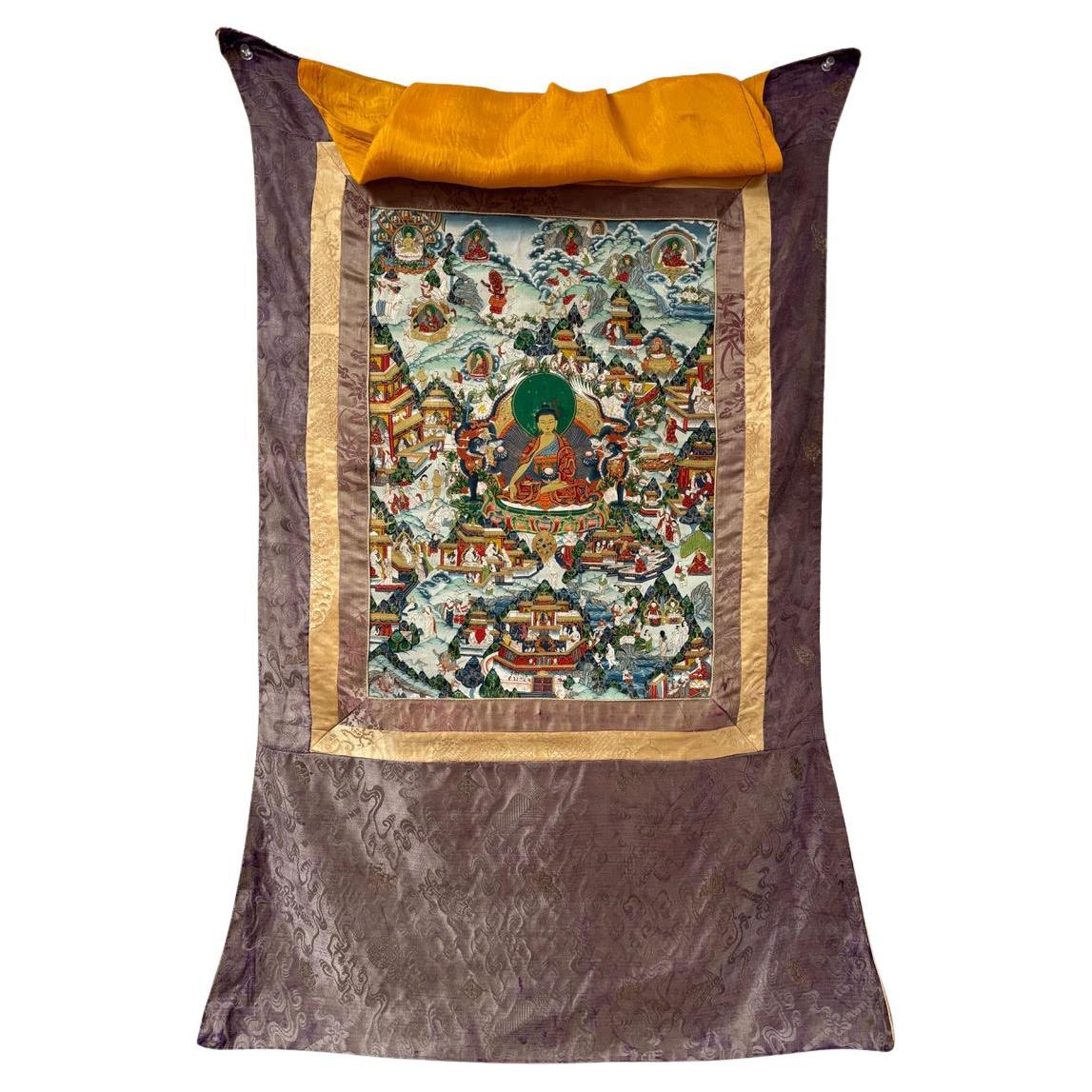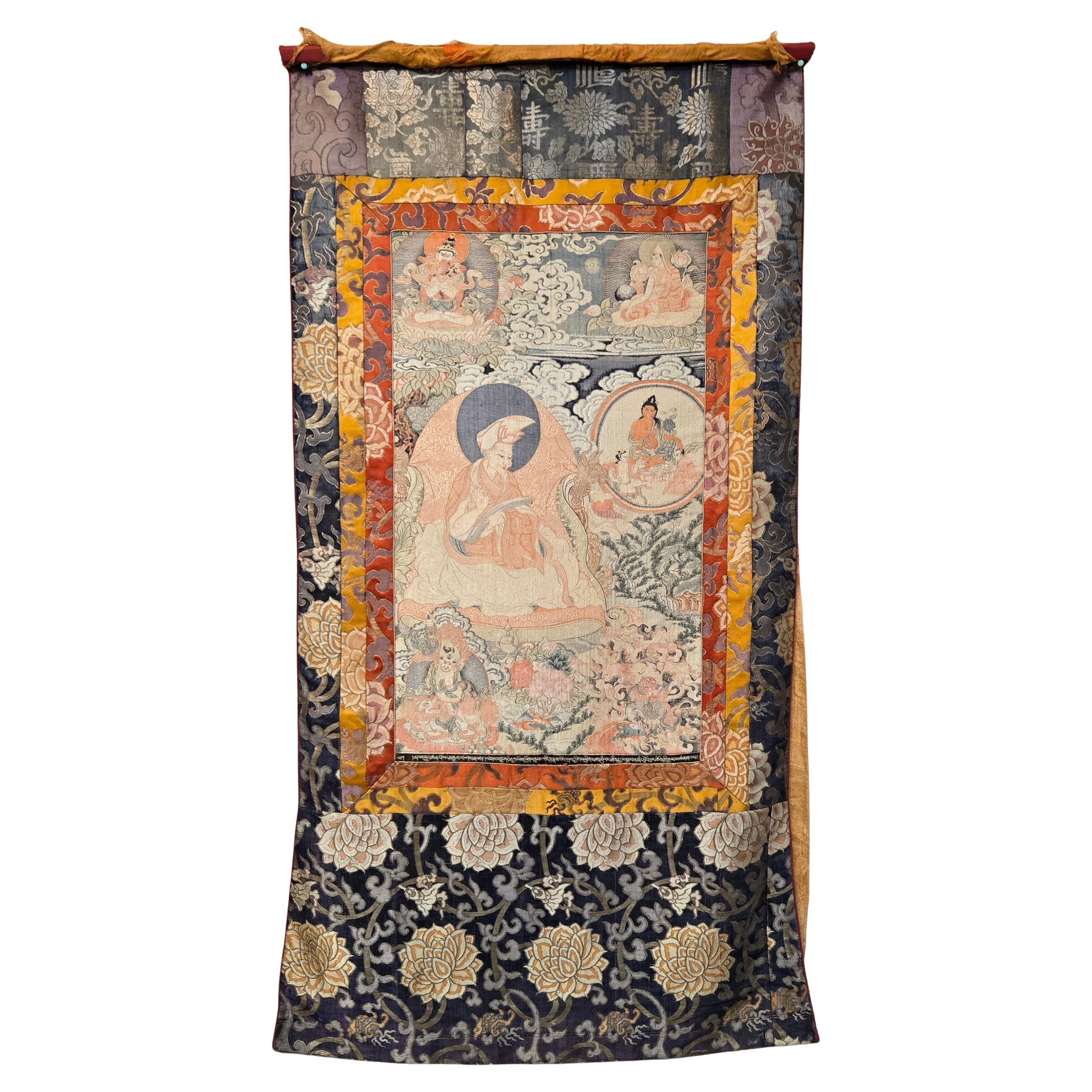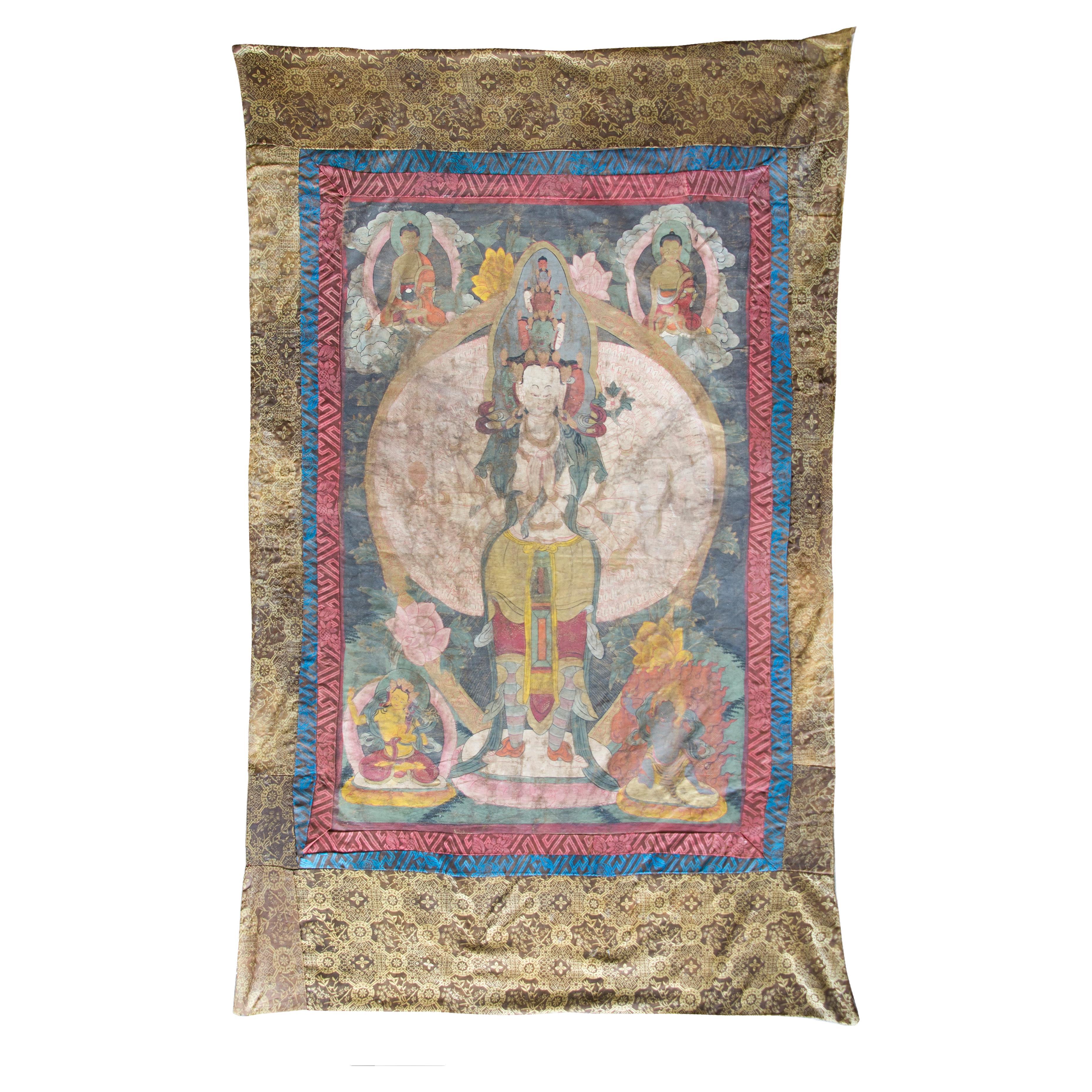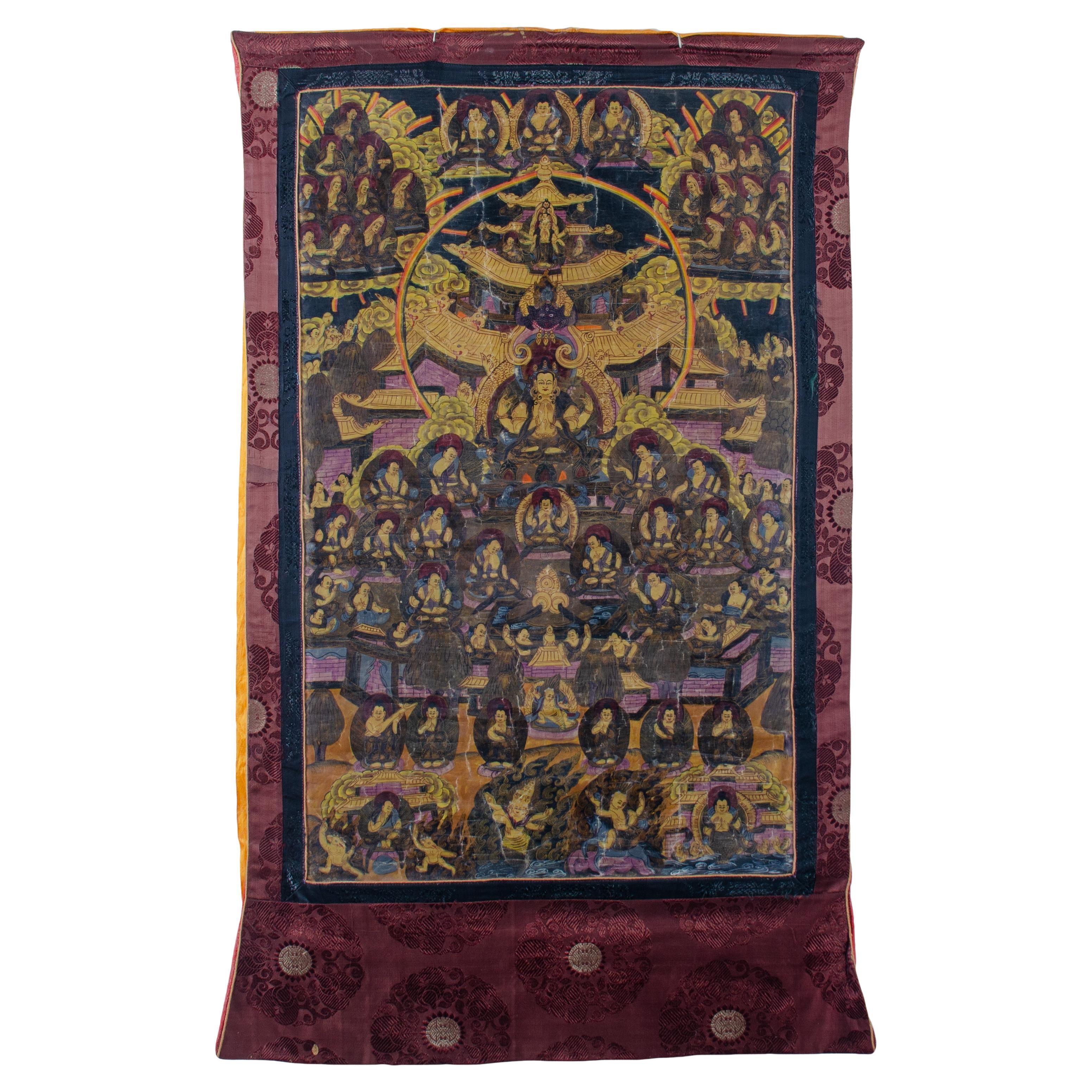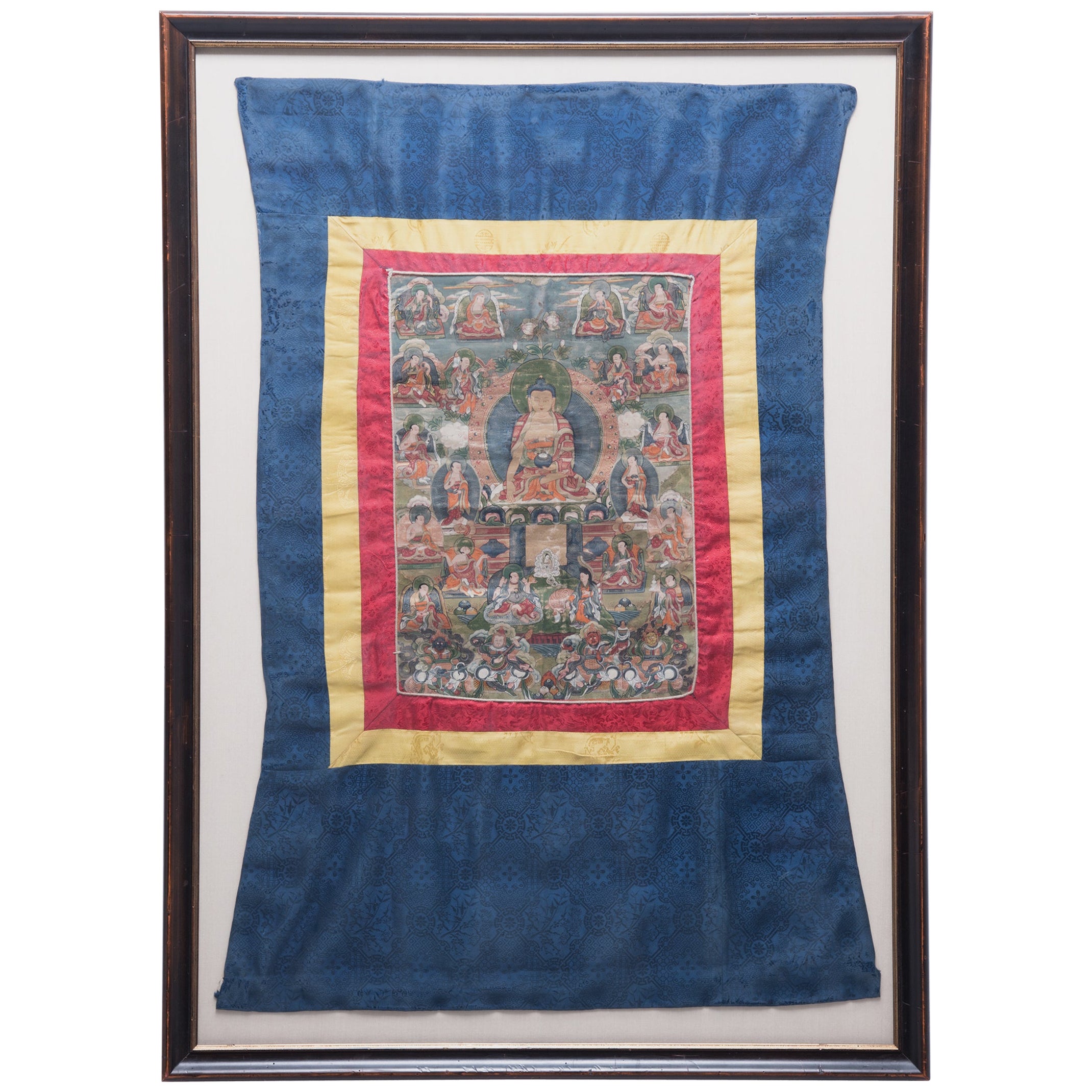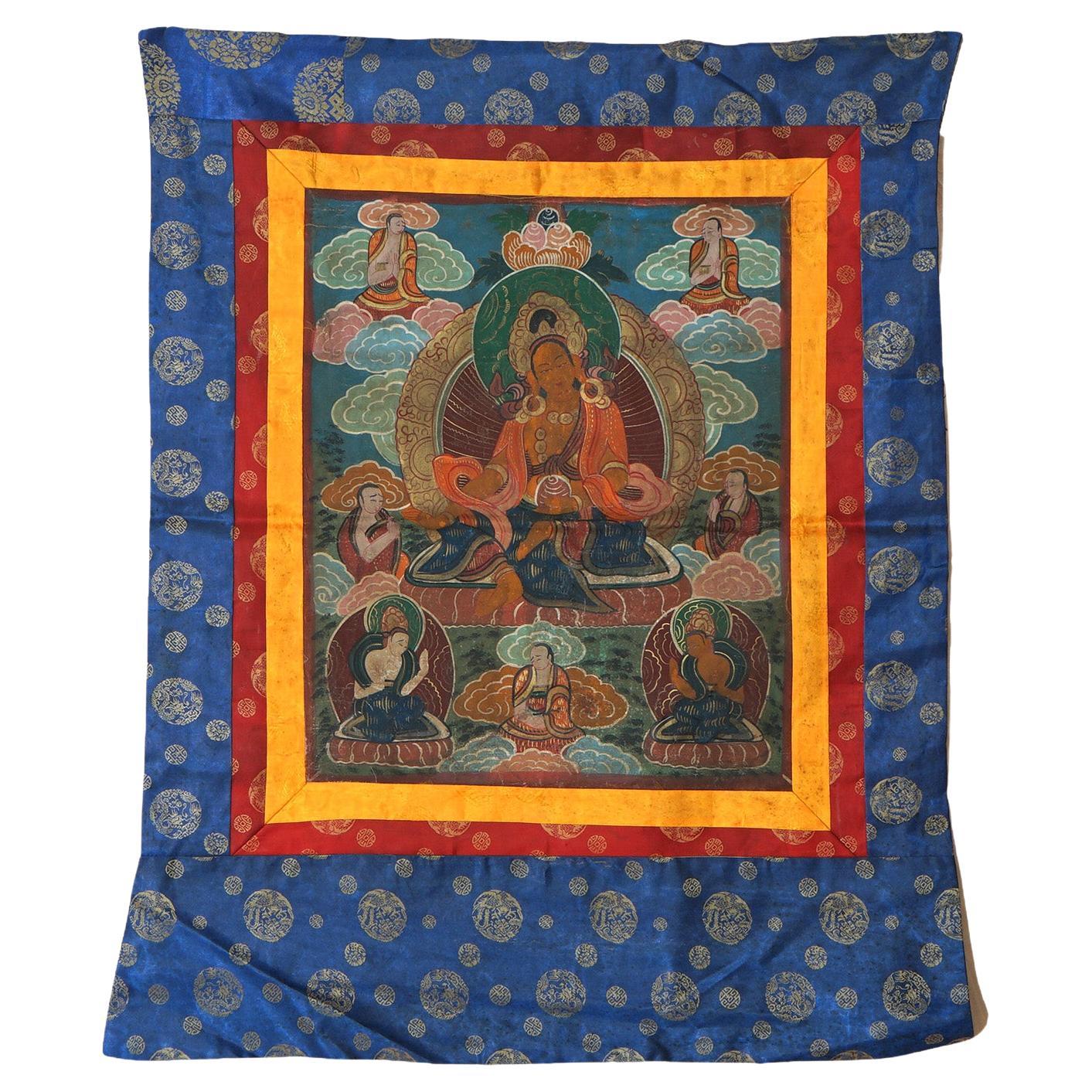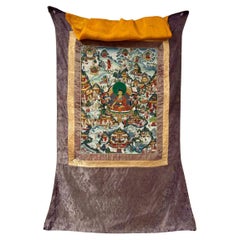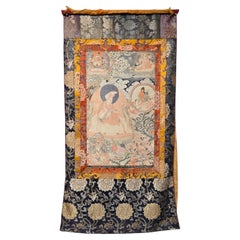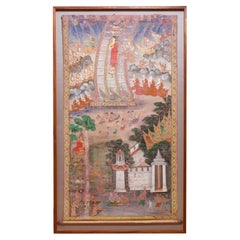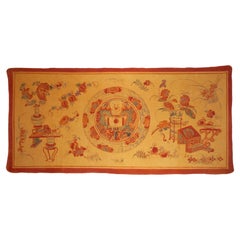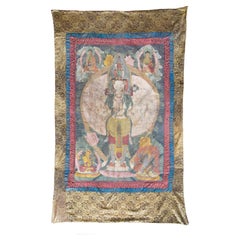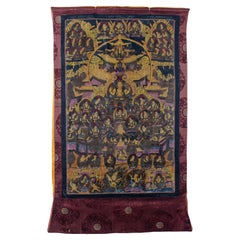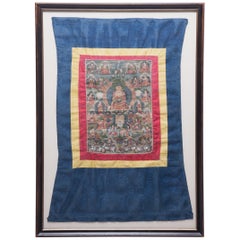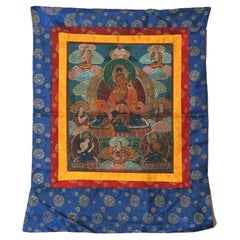Items Similar to Antique Dharma Protector Dharmapala Thangka Tapestry, 1920s
Video Loading
Want more images or videos?
Request additional images or videos from the seller
1 of 9
Antique Dharma Protector Dharmapala Thangka Tapestry, 1920s
$2,000
£1,511.75
€1,737.27
CA$2,784.99
A$3,098.18
CHF 1,624.11
MX$37,859.06
NOK 20,680.98
SEK 19,468.28
DKK 12,968.08
Shipping
Retrieving quote...The 1stDibs Promise:
Authenticity Guarantee,
Money-Back Guarantee,
24-Hour Cancellation
About the Item
Dated from the 1920s, painted paper on silk brocade. This Thangka depicts Dharmpala, one of the three ancient treasure protectors of Buddhist teaching, this one being named Rahula. It's lineage is from the Nyugna school of Tibetan buddhism. Rahula is related to the eclipse of the sun, moon and other planets. Ruhala is portrayed with the lower body of the coiled serpent and upper body with four arms, nine heads adorned with a thousand eyes representing the nine planets. He is in a wrathful state, with eyes all over his body and a bow and arrow, a vajra and other instruments held high, revealing that he can find those who break the precepts and subdue them with the power of wisdom and compassion. The many masters and venerables surrounding him show the source of his Dharma lineage.
Total Size: 51” x 30” Image Size: 30” x 22”
- Dimensions:Height: 51 in (129.54 cm)Width: 30 in (76.2 cm)Depth: 1 in (2.54 cm)
- Style:Tibetan (In the Style Of)
- Materials and Techniques:
- Place of Origin:
- Period:
- Date of Manufacture:1920
- Condition:Wear consistent with age and use.
- Seller Location:Point Richmond, CA
- Reference Number:Seller: GU-AL25031stDibs: LU1778244480272
About the Seller
5.0
Platinum Seller
Premium sellers with a 4.7+ rating and 24-hour response times
Established in 1999
1stDibs seller since 2015
686 sales on 1stDibs
Typical response time: 2 hours
- ShippingRetrieving quote...Shipping from: Point Richmond, CA
- Return Policy
Authenticity Guarantee
In the unlikely event there’s an issue with an item’s authenticity, contact us within 1 year for a full refund. DetailsMoney-Back Guarantee
If your item is not as described, is damaged in transit, or does not arrive, contact us within 7 days for a full refund. Details24-Hour Cancellation
You have a 24-hour grace period in which to reconsider your purchase, with no questions asked.Vetted Professional Sellers
Our world-class sellers must adhere to strict standards for service and quality, maintaining the integrity of our listings.Price-Match Guarantee
If you find that a seller listed the same item for a lower price elsewhere, we’ll match it.Trusted Global Delivery
Our best-in-class carrier network provides specialized shipping options worldwide, including custom delivery.More From This Seller
View AllAntique Shakyamuni Buddha Thangka Tapestry, 1950s
Located in Point Richmond, CA
Rare antique Thangka tapestry from around 1950. Depicting Siddhartha Guatama in the Pureland when he became Buddha and his Dharma name became Shakyamu...
Category
Mid-20th Century Tibetan Tibetan Scholar's Objects
Materials
Canvas, Silk
Antique Ascended Kagyu Master Thangka Tapestry, 1920s
Located in Point Richmond, CA
This rare antique 1920s embroidered silk Tibetan Thangka depicts images seldom seen of the greatly radicalized ones radiating divine love. The bottom left depicts Dzambhala, the Budd...
Category
Early 20th Century Tibetan Tibetan Scholar's Objects
Materials
Silk, Cotton
Antique Thai Buddhist Banner Painting
Located in Point Richmond, CA
Antique Thai Buddhist Banner Painting, multi-coloured tempera and gold leaf on cloth, depicting Buddha Descending From Tavatimsa Heaven. An illustration o...
Category
Antique 1850s Thai Other Paintings and Screens
Materials
Textile, Plexiglass
Antique Chinese Felt for the Japanese Market
Located in Point Richmond, CA
Antique Chinese Felt for the Japanese Market
This unique Chinese felt was imported into Japan in the early 1900s. Little in known about their specific use, or who or might have owne...
Category
Early 20th Century Chinese Tribal Tribal Art
Materials
Wool
Vintage Burmese Kalaga, Mandalay
Located in Point Richmond, CA
Vintage Burmese Kalaga, Mandalay.
A wall hanging embroidered tapestry inspired from a scene in the Jataka Tales. The embroidery depicts a prince riding...
Category
Mid-20th Century Burmese Other Textiles
Materials
Textile
Antique Chinese Printed Ink Rubbing of Panthaka Arhat, (scroll mounted)
Located in Point Richmond, CA
Chinese ink rubbing printing depicting Panthaka Arhat, no.4 of the 16 arhat images immortalized in stone at the former stupa at Shengyin Temple. Depicted here sitting on a rock with a book in his left hand and snapping his fingers in his right hand, symbolic of the speed at which he obtained enlightenment, accompanied by a beggar’s bowl and an incense burner, complete with colophons and silk scroll mounting. The Emperor Qianlong ordered the stone stele to be carved in 1764 after the arhat designs painted by the famed artist Guanxiu (832-912). Even though the temple was destroyed in the Taiping rebellion, the steles remain and have been reinstalled at the Hangzhou Stele Forest. Condition: Creases from rolling, otherwise fine condition. Mounting: 58” x 22”. 19th Century. Ex Collection: Frank “Till” & Peggy Durdin, San Diego.
For other rubbings of this stele see:
Penn Museum, object number 2010-26-4
The Metropolitan Museum of Art AN#: 59.195.15
Fine Arts Library of Harvard University, record id: W280021_urn-3:FHCL:478850
For another example of this image rendered in jade and lacquer see: “Screen Paintings of Guanxiu’s Sixteen Arhats in the Collection of the Palace Museum” Luo Wehhua translated by Bruce Doar, Orientations, September 2010, p. 104. In this article the image is identified as the sixteenth arhat Abheda, It is explained in this article that Qianlong re-identified the arhats, thus the 16th Arhat attribution for this image. Also in this article the identical colophon by Qianlong above the image is translated as: “These accurate portraits of the Sixteen Arhats were created by the Tang Dynasty painter Guanxiu, as recorded in Xuanhe Huapu (Record of paintings in the Xuanhe Reign), and during the millennium from the Guangming reign period to the present day, the original works were to be found in Zhejiang, where they were housed in the collection of Shengyin Temple in Qiantang (Huangzhou). In spring of the dingchou year (1757) of his reign, the Qianlong emperor undertook a southern tour of inspection and stayed at an imperial lodge on the West Lake. He went to the temple to pay his respects and there he saw the arhats on display and wrote a description of these marvels. The sequence of the arhats and their names had been passed down since ancient times, but they did not correspond to their Sanskrit titles; the sequence of the arhat names conformed instead to the interpretation of the Sanskrit classics by the Zhangjia State Preceptor. The emperor penned the original names and positions in the sequence below each of the figures in accordance with the readings supplied in Tongwen Yuntong (Unified Rhymes), and below each he penned an encomium, which he signed. Then the images were returned to the collection, to be passed down as a perpetual treasure. Now, the fourth great arhat had long gone missing and we did not know where his painting was. But it was merely a trifling matter of matching the images with the names, and now surely we have found him! This I, the emperor, believe.”
All 16 of these rubbings can be found in the Rubel Chinese Rubbings Collection at the Fine Arts Library of Harvard University with the following descriptive historical note: “Rubbing from stele depicting No. 4 of 16 arhats (Lohans, Buddhist saints) -- Nan ti mi duo luo qing you, Panthaka Arhat. Original painting attributed to Guanxiu, 832-912. Inscriptions written by Hongli, Emperor Qianlong (Gaozong, 1711-1799) of Qing Dynasty. 7 seals of Qianlong follow the inscriptions. Script style: in xing shu. Shi liu zun zhe -- "The 16 noble ones" are 16 lohans. Lohans are also called "a-lo-han" based on the transliteration of the Sanskrit term "arhat." (Japanese: Rakan; Chinese: Lohan; Tibetan: Gnas-brtan). Arhats or Arahants are saints or sages said to have renounced nirvana (freedom from the cycle of suffering and rebirth), vowed to remain in the world to protect the Dharma and propagate the Law of the Buddha in order to devote themselves more effectively to the relief of human misery, like the Bodhisattvas. These 16 Arhats, personal disciples distinguished by the Buddha, formed part of the 500 claimed by tradition to have attended the First Council in Rajagrha. The names and abodes of these 16 arhats are given in a work entitled "Record on the Duration of the Law, spoken by the Great arhat Nadimitra," which was translated into Chinese by the famous pilgrim Xuanzang (596-664) in 654. 16 lohans are quite often represented, especially in China and Japan, in sculpture and painting, in poses and with attributes. Every lohan can be easily with special icongraphic characteristics. Guanxiu (Jiang Deyin or Deyuan, a Buddhist monk also named Master Chan Yue, 832-912) -- painter during late Tang to Five Dynasties, specialized in painting lohan figures. Legend has it that the first portraits of the 18 Lohans...
Category
Antique 19th Century Chinese Qing Prints
Materials
Paper
You May Also Like
Late 19th Century Tibetan Thangka Depicting Sitatapattra
Located in Chicago, IL
A stunning late 19th century Tibetan Thangka depicting the Buddhist goddess, Sitatapattra. The term "Sitatapatra" translates to mean "White Umbrella" or "White Parasol," emphasizing ...
Category
Antique Late 19th Century Tibetan Tibetan Paintings
Materials
Linen, Paint
Chenrezig Silk Thangka, 20th Century
Located in Savannah, GA
A silk painted Tibetan thangka depicting Chenrezig, early 20th century.
sight of painting: 19 by 30 ¾ inches
total dimensions: 24 by 40 ½ inches
Category
20th Century Tibetan Paintings and Screens
Materials
Silk
Tibetan Thangka of Sakyamuni with Silk Brocade, C. 1880
Located in Chicago, IL
Historically in Buddhist Tibet, patrons and monks commissioned thangka art, or sacred painting, to focus their meditations and prayers. This 19th-century Tibetan Thangka, painted in rich red, green, and blue pigments, still maintains incredible vibrancy. The central figure is the Sakyamuni Buddha, seated in the diamond position with alms bowl...
Category
Antique Late 19th Century Tibetan Tibetan Paintings and Screens
Materials
Linen, Silk
Antique Tibetan Hand Painted Silk and Canvas Thangka with Figures C1920
Located in Big Flats, NY
Antique Tibetan Hand Painted Silk and Canvas Thangka with Figures C1920
Measures- 37''H x 31''W x .25''D
Category
Early 20th Century Tibetan Tibetan Paintings and Screens
Materials
Canvas, Silk, Paint
$760 Sale Price
20% Off
Antique Tibetan Hand Painted Silk and Canvas Thangka with Figures C1920
Located in Big Flats, NY
Antique Tibetan Hand Painted Silk and Canvas Thangka with Figures C1920
Measures- 36''H x 30.75''W x .25''D
Category
Early 20th Century Tibetan Tibetan Paintings and Screens
Materials
Canvas, Silk, Paint
$520 Sale Price
20% Off
20th Century Antique Tibetan Hand Painted Thangka, Avalokitshvara, Kuan Yin
Located in Pomona, CA
Tibetan Thangka, Kuan yin (Avalokitshvara), finely painted with colored inks on silk. It is all hand painted with Tibetan natural mineral color painting material which can last for a...
Category
Early 20th Century Chinese Chinese Export Textiles
Materials
Fabric
More Ways To Browse
Bow Arrows
Used Bows And Arrows
Tibet Antiques
Antique Bow And Arrow
Tibetan Buddhist Art
Asian Arrow
Tibetan Thangka
Tibetan Head
Antique Thangkas
Thangka Art
Antique Tibetan Thangka
Tibetan Tapestry Silk
Tibet Thangka
Antique Thangka Tibet
Japanese Scholars Box
Korean Calligraphy
Chinese Brush Washer
Bamboo Brush Pot
